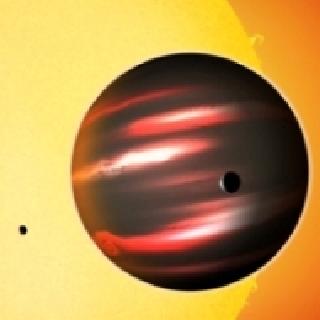
An artist's conception of the planet TrES-2b. An RAS photo
LONDON (BNS): A Jupiter-sized alien planet darker than the blackest coal has caught the attention of astronomers who are trying the figure out what makes the distant world so black.
The exoplanet, designated TrES-2b and discovered in 2006, orbits its host star GSC 03549-02811 which is located about 750 light-years away in the constellation Draco.
The gas giant, bearing a very hot temperature at over 1000 degrees Celsius, orbits the star at a distance of only five million kilometres. It reflects less than one percent of the sunlight falling on it, making it blacker than coal or any planet or moon in our Solar System.
“TrES-2b is considerably less reflective than black acrylic paint, so it’s truly an alien world,” said astronomer and lead author David Kipping of the Harvard-Smithsonian Center for Astrophysics (CfA).
While in our Solar System, Jupiter is swathed in bright clouds of ammonia that reflect more than a third of the sunlight reaching it, the planet TrES-2b lacks such reflective clouds due to its high temperature, say the astronomers.
In contrast, the planet’s exotic atmosphere contains light-absorbing chemicals like vaporized sodium and potassium, or gaseous titanium oxide.
Yet none of these chemicals fully explain the extreme blackness of TrES-2b.
“It's not clear what is responsible for making this planet so extraordinarily dark,” stated co-author David Spiegel of Princeton University. “However, it's not completely pitch black.
It's so hot that it emits a faint red glow, much like a burning ember or the coils on an electric stove.”
Using data from NASA’s Kepler spacecraft, astronomers have determined the reflectivity of TrES-2b during its orbital transits around its host star.
The team monitored the brightness of TrES-2 in over 50 orbits and detected a subtle dimming and brightening due to the planet’s changing phase.
The planet is believed to be tidally locked like our Moon, so one side of the planet always faces the star. And like our Moon, the planet shows changing phases as it orbits its star.
This causes the total brightness of the star and the planet to vary slightly.
The extremely small fluctuations proved that TrES-2b is “incredibly dark.” A more reflective world would have shown larger brightness variations as its phase changed, said the researchers.
The team publishes its latest findings in the journal Monthly Notices of the Royal Astronomical Society.
 Previous Article
Previous Article Next Article
Next Article













The Indian Air Force, in its flight trials evaluation report submitted before the Defence Ministry l..
view articleAn insight into the Medium Multi-Role Combat Aircraft competition...
view articleSky enthusiasts can now spot the International Space Station (ISS) commanded by Indian-American astr..
view article